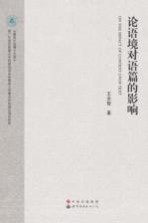图书介绍
论语境对语篇的影响 英文版PDF|Epub|txt|kindle电子书版本网盘下载

- 王全智著 著
- 出版社: 广州:世界图书广东出版公司
- ISBN:9787510069918
- 出版时间:2014
- 标注页数:198页
- 文件大小:25MB
- 文件页数:218页
- 主题词:语言学-英文
PDF下载
下载说明
论语境对语篇的影响 英文版PDF格式电子书版下载
下载的文件为RAR压缩包。需要使用解压软件进行解压得到PDF格式图书。建议使用BT下载工具Free Download Manager进行下载,简称FDM(免费,没有广告,支持多平台)。本站资源全部打包为BT种子。所以需要使用专业的BT下载软件进行下载。如BitComet qBittorrent uTorrent等BT下载工具。迅雷目前由于本站不是热门资源。不推荐使用!后期资源热门了。安装了迅雷也可以迅雷进行下载!
(文件页数 要大于 标注页数,上中下等多册电子书除外)
注意:本站所有压缩包均有解压码: 点击下载压缩包解压工具
图书目录
Chapter 1 Introduction1
1.1 Rationale1
1.1.1 Motivation of this study3
1.1.1.1 Sterility of structuralist studies of language3
1.1.1.2 Limitations of Z.S.Harris's Discourse Analysis8
1.1.2 Insufficiency of Halliday's exploration of context and text11
1.1.3 Significance of this current study12
1.2 Research Methodology12
1.3 Collection and selection of corpora13
1.3.1 Data collection and selection13
l.3.2 Justification for the adoption of spoken prose as corpora13
l.3.3 Transcription of real-life spoken data14
1.4 Theoretical framework of this study15
1.5 Structure of this research16
Chapter 2 Literature Review on Context of and Text18
2.1 Introductory remarks18
2.2 Context18
2.2.1 Context defined by different linguists19
2.2.1.1 Malinowski's definition of context19
2.2.1.2 J.R.Firth's definition of context21
2.2.1.3 Halliday and Hasan's notion of context22
2.2.1.4 Roman Jacobson's definition of context23
2.2.1.5 D.Hymes's definition of context25
2.2.1.6 Elinor Ochs's definition of context29
2.2.1.7 CHEN Wangdao's definition of context30
2.2.2 Cognitive context31
2.2.2.1 Philosophers'statement of objective context and cognitive context32
2.2.2.2 Context in cognitive linguistics34
2.2.2.3 Problems with the theory of cognitive context35
2.3 Text35
2.3.1 Text,discourse,conversation35
2.3.1.1 van Dijk's definition of text and discourse36
2.3.1.2 Halliday and Hasan's definition of text37
2.3.1.3 Brown and Yule's definition of discourse and text38
2.3.1.4 Beaugrande and Dressler's definition of text38
2.3.1.5 Coulthard's definition of discourse40
2.3.1.6 Fowler's notion of text and discourse40
2.4 Text and Context in this research41
2.4.1 Text in this research42
2.4.1.1 Informativity42
2.4.1.2 Semantic compatibility47
2.4.1.3 Associability48
2.4.1.4 Cognitivity49
2.4.1.5 Length felicity51
2.4.2 Context in this research53
Chapter 3 Impact of Field upon Text55
3.1 Introductory remarks55
3.2 Field and its components56
3.2.1 Suzanne Eggins's description of field57
3.2.2 Leckie-Tarry's description of field58
3.2.2.1 Arena/activities58
3.2.2.2 Participants59
3.2.2.3 Semantic domain60
3.2.3 A brief summary61
3.3 The impact of field upon text63
3.3.1 The impact of subject matter upon text63
3.3.2 The impact of participants upon text68
3.3.3 The impact of setting upon text74
3.3.3.1 Conversation inside the classroom75
3.3.3.2 Conversation outside the classroom83
3.4 Summary86
Chapter 4 Impact of Tenor upon Text87
4.1 Introductory remarks87
4.2 Different definitions of tenor87
4.2.1 Gregory's definition of tenor88
4.2.1.1 Personal tenor88
4.2.1.2 Functional tenor89
4.2.2 Poynton's definition of tenor91
4.2.2.1 Power91
4.2.2.2 Contact92
4.2.2.3 Affective involvement92
4.2.3 Martin's definition of tenor93
4.2.3.1 Status93
4.2.3.2 Contact93
4.2.3.3 Affect94
4.2.4 Leckie-Tarry's definition of tenor94
4.2.4.1 Formality94
4.2.4.2 Role95
4.2.4.3 Focus95
4.2.5 A brief summary96
4.3 Impact of tenor upon text99
4.3.1 Impact of power upon text99
4.3.2 Impact of contact upon text105
4.3.3 Impact of affective involvement upon text113
4.4 Summary116
Chapter 5 Impact of Mode upon Text117
5.1 Introductory remarks117
5.2 Definitions of mode117
5.2.1 Halliday's definition of mode117
5.2.2 Leckie-Tarry's definition of mode118
5.2.2.1 Planning118
5.2.2.2 Feedback119
5.2.2.3 Contextualization120
5.2.2.4 Medium121
5.2.3 Martin's definition of mode122
5.2.3.1 Spatial/interpersonal distance122
5.2.3.2 Experiential distance123
5.2.4 Summary of the quoted definitions125
5.2.5 The definition of mode to be taken in this research126
5.3 Impact of mode upon text126
5.3.1 Differences between spoken mode and written mode126
5.3.1.1 Referential choices between spoken mode and written mode131
5.3.1.2 Nominalization:a typical feature of written mode132
5.3.2 Written-to-be-spoken mode and its actualization137
5.3.3 Internet relay chat and face-to-face conversation142
5.3.3.1 Sequential organization in QS-CMC:The misinterpretation of adjacency144
5.3.3.2 Phantom responsiveness and phantom adjacency pairs145
5.3.3.3 Turn-taking in QS-CMC:The problem of virtual simultaneity149
5.3.3.4 The misinterpretation of silence152
5.3.3.5 Miscommunication in QS-CMC153
5.4 Summary155
Chapter 6 Interaction between Contextual Factors and Its Impact upon Text156
6.1 Introductory remarks156
6.2 Contextual factors revisited157
6.3 Impact of field upon mode159
6.4 Impact of mode upon tenor163
6.5 Impact of tenor upon field169
6.6 Impact of tenor on mode170
6.7 Impact of field upon tenor176
6.8 Summary178
Chapter 7 Conclusion179
7.1 Conclusions179
7.2 Contributions of the current research179
7.3 Insufficiencies of the current research180
7.4 Suggestions for future research182
7.5 Pedagogical implications of this research183
References186